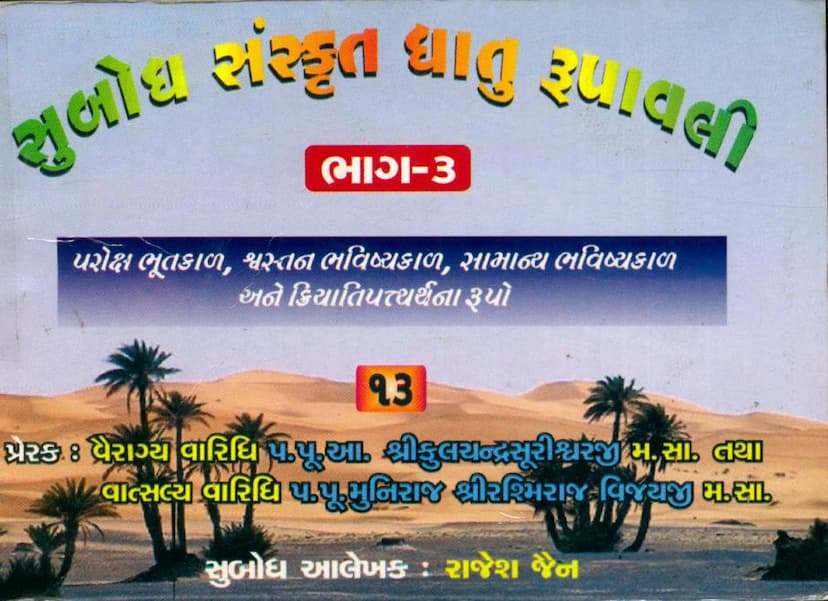Subodh Sanskrit Dhatu Rupavali Part 03
Added to library: September 2, 2025

Summary
Here's a comprehensive summary of the Jain text "Subodh Sanskrit Dhatu Rupavali Part 03" by Rajesh Jain, published by Tattvatrai Prakashan, based on the provided text:
Book Title: Subodh Sanskrit Dhatu Rupavali Part 03 Author: Rajesh Jain Publisher: Tattvatrai Prakashan
Core Content and Purpose:
This book, "Subodh Sanskrit Dhatu Rupavali Part 03," is the third volume in a series focused on Sanskrit verb roots (dhatus) and their conjugations. The series aims to provide a clear and accessible understanding of Sanskrit grammar, specifically for Jain students and scholars. This particular volume focuses on the following grammatical aspects of Sanskrit verbs:
- Puroksha Bhutkal (परोक्ष भूतकाल): The Past Perfect tense.
- Shvastan Bhavishyakal (श्वस्तन भविष्यकाल): The Future Perfect tense (indicating an action that will have been completed).
- Samanya Bhavishyakal (सामान्य भविष्यकाल): The Simple Future tense.
- Kriyatipatyarth (क्रियातिपत्यर्थ): The Conditional mood or potential mood, often used to express actions that should or might happen.
- Prerak (प्रेरक): Causative forms of verbs (indicating someone causing another to perform an action).
Key Features and Structure:
- Comprehensive Coverage: The book meticulously details the various forms (rupas) that Sanskrit verb roots take in the specified tenses and moods. The extensive table of contents (Anukramanika) on pages 8-15 reveals a vast array of verb roots and their conjugations.
- Categorization of Verbs: The text categorizes Sanskrit roots into different classes, including:
- Setu (सेटू): Roots that take the augment 's' in certain tenses.
- Anit (अनिट): Roots that do not take the augment 's'.
- Vet (वेट): Roots that are neither Setu nor Anit, or have special conjugations.
- Detailed Presentation: The book provides the conjugations of numerous verb roots, often following the pattern of the root, its meaning, and then its various forms in the relevant tenses and moods. Examples include roots like 'अद्' (to eat), 'गम्' (to go), 'कृ' (to do), 'दृश्' (to see), and many others.
- Inspiration and Dedication: The book is dedicated to respected Jain Acharyas and Munis, including Acharya Shri Kulchandrasurishwarji Maharaj and Muni Shri Rashmirajvijayji Maharaj. It explicitly mentions being inspired by Muni Shri Rashmirajvijayji Maharaj.
- Accessibility: The title "Subodh" suggests the book is intended to be easily understood (sub-bodh). The author, Rajesh Jain, is credited with meticulously compiling this information.
- Educational Focus: The publisher, Tattvatrai Prakashan, along with "Divya Darshan Karyalaya" and "RAJ ARTS," are involved in making this text available. The publication information indicates a clear intention for educational dissemination.
Significance for Jain Education:
This book is a crucial resource for learning Sanskrit grammar within the Jain tradition. By systematically presenting the conjugations of Sanskrit verbs, it helps students:
- Understand and interpret Sanskrit texts: Many ancient and foundational Jain scriptures are written in Sanskrit. Proficiency in Sanskrit grammar is essential for accurate comprehension.
- Deepen their knowledge of philosophical and spiritual concepts: Sanskrit is the language of many philosophical treatises and spiritual teachings in Jainism.
- Master the nuances of verbal expression: The detailed breakdown of tenses and moods allows for a sophisticated understanding of how actions are described and understood in Sanskrit.
Overall:
"Subodh Sanskrit Dhatu Rupavali Part 03" is a highly specialized and educational work dedicated to providing a thorough grammatical resource for Sanskrit verb conjugations, with a particular focus on the Past Perfect, Future Perfect, Simple Future, Conditional moods, and causative forms. It serves as a vital tool for those seeking to master Sanskrit within the Jain tradition, contributing significantly to the preservation and dissemination of Jain knowledge.